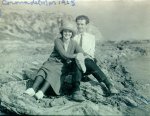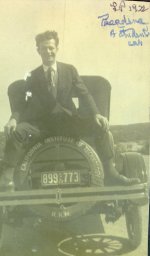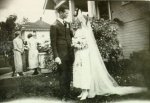
Linus Pauling as a Graduate and Postdoctoral Student at the California Institute of Technology, Part 1 (1922-1923)
1922
In the third week of September, Pauling arrives at the California Institute of Technology in Pasadena. He lives with Paul Emmett and his mother at 1005 Oakdale Street, and he becomes James Bell’s teaching assistant in general chemistry.
Pauling’s first-year courses include advanced calculus and chemical thermodynamics.
He begins research in X-ray crystallography under the direction of Roscoe G. Dickinson.
During November and December, Pauling makes about twelve crystals and takes several of them through the initial stages of X-ray analysis, but none turns out to be suitable for a structure determination. Dickinson helps his graduate student out by choosing molybdenite and showing him how a cleaved section of the crystal can be mounted and subjected to X-ray analysis. Pauling and Dickinson are readily able to work out the structure of molybdenite using Dickinson’s rigorous techniques.
1923
During the second term, Pauling takes Richard Chace Tolman’s course, Introduction to Mathematical Physics. Tolman influences Pauling to become a theoretical physical chemist.
Near the end of April, Dickinson and Pauling send their paper on the structure of molybdenite to the Journal of the American Chemical Society (JACS), where it is published in June. This constitutes Pauling’s first published paper (he had published a few pieces while he was an OAC student, but these have only provincial interest).
During his third term (March 26 to June 12), Pauling takes Tolman’s course in advanced thermodynamics. He becomes interested in quantum theory, reads Arnold Sommerfeld’s Atombau und Spektrallinien (Atomic Structure and Spectral Lines), and learns about up-to-date research in quantum theory through the physics and chemistry research conferences.
Arnold Sommerfeld visits CIT and talks about his work on quantum theory. In the course of his lectures, Sommerfeld uses crystal models he had brought from Germany. Pauling shows Sommerfeld some of the models that he has constructed, which are actually much better than Sommerfeld’s.
Pauling determines the structure of the intermetallic compound, magnesium stannide, using Dickinson’s X-ray crystallographic technique.
Through their letters, Linus and Ava Helen have decided to marry at the end of his first year of graduate studies, despite the opposition of their mothers.
In June, Pauling uses $50 that he has saved to buy a seven-year-old Model T Ford from Dickinson.
On the trip back to Oregon for his marriage, Pauling crashes, in the middle of the night, into a borrow pit in the Siskiyou Mountains of northern California. His leg is injured and the roof of his Model T Ford is badly crushed. He manages, in the morning, to get help to repair the car and to bandage his leg. He arrives in Salem later than expected but in time for his wedding.
On June 17, Linus Pauling marries Ava Helen Miller in Salem, Oregon. Ward Willis Long, pastor of the First Presbyterian Church, is the minister. Lloyd Jeffress is best man.
After a one-day honeymoon in Corvallis, Pauling begins work in the Portland laboratory of the Warren Construction Company (he and his new wife live with his mother). After a training period, he works for this construction company in the state of Washington before moving south into Oregon. In all these places, he works as a paving-plant inspector, while his wife keeps house in a series of little apartments.
In September, Linus and Ava Helen Pauling travel to Pasadena in the repaired Model T Ford. They rent an apartment in a private home on Washington Street, about a ten-minute walk north from the CIT campus.

Ava Helen and Linus Pauling on the beach at Corona del Mar, California, 1924.
LP Photographs, 1924i.3
Pauling forms a friendship with Maurice L. Huggins, a postdoctoral student who shares many of Pauling’s interests.
Pauling works on a series of complex fluoride compounds by using a powder diffraction X-ray apparatus of his own construction.
Besides research, Pauling takes the heaviest course load of his graduate career, including vector analysis and kinetic theory (this latter course is taught by Robert A. Millikan, who finds out during it that he has been awarded the 1923 Nobel Prize in Physics for his work on the determination of electronic charge).
Linus and Ava Helen Pauling help arrange the secret marriage of Lloyd Jeffress to Sylvia Bloomberg. Jeffress has just received his bachelor’s degree from Berkeley (he majored in psychology) and has begun graduate studies. The subterfuge is necessary because Sylvia’s parents did not approve of the marriage.
Table of Contents
- The Ancestry of Linus Pauling (The Paulings)
- The Ancestry of Linus Pauling (The Darlings)
- Linus Pauling's Childhood (1901-1910)
- Linus Pauling's Adolescence (1910-1917)
- Pauling's Years as an Undergraduate at Oregon Agricultural College, Part 1 (1917-1919)
- Pauling's Years as an Undergraduate at Oregon Agricultural College, Part 2 (1919-1922)
- Linus Pauling as a Graduate and Postdoctoral Student at the California Institute of Technology, Part 1 (1922-1923)
- Linus Pauling as a Graduate and Postdoctoral Student at the California Institute of Technology, Part 2 (1924-1926)
- A Guggenheim Fellow in Europe during the Golden Years of Physics (1926-1927)
- Early Career at the California Institute of Technology (1927-1930)
- Pauling's Great Years of Achievement in Structural Chemistry, Part 1 (1931-1932)
- Pauling's Great Years of Achievement in Structural Chemistry, Part 2 (1933-1935)
- Pauling's Increasing Involvement in Molecular Biology (1936-1939)
- The War Years, Part 1 (1940-1942)
- The War Years, Part 2 (1943-1945)
- The Postwar Years, Part 1 (1946-1947)
- The Postwar Years, Part 2 (1948-1949)
- Proteins, Passports, and the Prize (1950-1954)
- Increasing Involvement in World Peace, Part 1 (1955-1958)
- Increasing Involvement in World Peace, Part 2 (1959-1963)
- The Center for the Study of Democratic Institutions (1964-1967)
- The University of California, San Diego (1968-1969)
- Stanford University (1969-1972)
- An Institute for Science and Orthomolecular Medicine, Part 1 (1973-1977)
- An Institute for Science and Orthomolecular Medicine, Part 2 (1978-1981)
- The Years Alone: Pauling after the Death of Ava Helen, Part 1 (1982-1988)
- The Years Alone: Pauling after the Death of Ava Helen, Part 2 (1989-1994)
- About the Author



